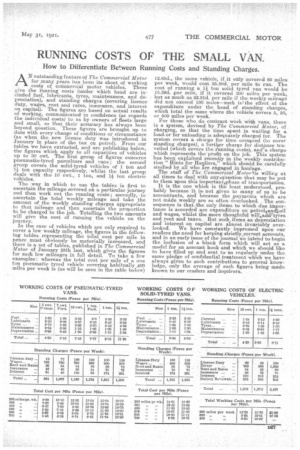RUNNING COSTS OF THE SMALL VAN.
Page 29

If you've noticed an error in this article please click here to report it so we can fix it.
How to Differentiate Between Running Costs and Standing Charges.
AN outstanding feature of The Commercial Motor for many years has been its sheet of working costs of commercial motor vehicles. These give the running costs (under which head are included fuel, lubricants, tyres, maintenance, and depreciation), and standing charges (covering licence duty, wages, rent and rates, insurance, and interest on capital). The figures are based on actual results of working, communicated in confidence (as regards the individual costs) to us by owners of fleets large and small, so that their accuracy has always been beyond question. These figures are brought up to date with every change of conditions or circumstance (as when the new licence duty was introduced in January in place of the tax en petrol). From our tables we have extracted, and are publishing below, the figures which apply to all capacities of vehicles up to 30 cwt. The first group of figures concerns pneumatic-tyred pareelcars and vans; the second group covers the solid-tyred vehicles of 1 ton and '11 ton capacity respectively, whilst the last group deals with the 16 cwt, I ton, and li ton electric vehicles.
The way in which to use the tables is first to ascertain the mileage covered on a particular journey and then work out the running costs; secondly, to ascertain the total weekly mileage and take the amount of the weekly standing charges appropriate to that mileage and then ascertain the proportion to bo charged to the job. Totalling the two amounts will give the cost of running the vehicle on the j ourney.
In the case of vehicles which are only required to cover a low weekly mileage, the figures in the fallowing tables representing the toIal cost per mile in pence must obviously be materially increased, and there is a set of tables, published in The Commercial Motor of January th last, which gives the figures for such low mileages in full detail. To take a few examples: whereas the total cost per mile of a one ton pneumatic tyred vehicle covering habitually .,400 miles per week is (as will be seen in the table below)
12.65d., the same vehicle, if, it ohly covered 80 miles per week, would cost 25.80d. per mile to run. The cost of running a 1i ton solid tyred van would be 13.39d. per mile, if it covered 300 miles per week, but as much as 22.5Id. per mile if the.sveekly mileage did not exceed 100 miles—such iW:the effect of the expenditure under the head of standing charges, which total the same where the vehicle covers 5, 50, or 500 miles per week.
For those who do contract work with vans, there is a system, devised by The Commercial Motor, of charging, so that the time apent in waiting for a. loador for unloading is adequately charged for. The system covers a charge for time occupied (to cover standing charges), a further charge for distance -travelled (which covers the running costs), ancra charge which represents the profit on the job. This system has been explained recently in the weekly contribution "Hints for Hauliers," which should be carefully studied by all who are engaged in haulage. The staff a The Commercial ..4fotorlis willing at all times to deal with anyiquestion.that may be put to them -upon this important,phase of transportation. It is the one which is the least,understood, probably because it is. not given to many of us to be accountants, and because the ;payments which are not made weekly are so often overlooked. The consequence is that. the only items to Which due importance is accorded are expenditure on petrolsand2oil and wages, whilst the more thoughtful willodchltyres and rent and taxes. But sueh_items as depreciation and 'interest on capital are almost invariably overlooked. We have constantly impressed upon our rea,flers the need for keeping strictlyneorreet accounts, and in an early issue of the journal we intend to begin the inclusion of a blank form which will act as a model for an account book and which we should like to have filled up and sent to us regularly under the same pledge of confidential ,treatment. which we have always given to such contributions to general knowledge, only the average of such figures being made known to our readers and inquirers.










































